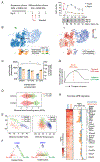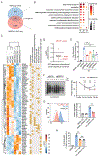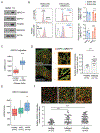QRICH1 dictates the outcome of ER stress through transcriptional control of proteostasis
- PMID: 33384352
- PMCID: PMC8315080
- DOI: 10.1126/science.abb6896
QRICH1 dictates the outcome of ER stress through transcriptional control of proteostasis
Abstract
Tissue homeostasis is perturbed in a diversity of inflammatory pathologies. These changes can elicit endoplasmic reticulum (ER) stress, protein misfolding, and cell death. ER stress triggers the unfolded protein response (UPR), which can promote recovery of ER proteostasis and cell survival or trigger programmed cell death. Here, we leveraged single-cell RNA sequencing to define dynamic transcriptional states associated with the adaptive versus terminal UPR in the mouse intestinal epithelium. We integrated these transcriptional programs with genome-scale CRISPR screening to dissect the UPR pathway functionally. We identified QRICH1 as a key effector of the PERK-eIF2α axis of the UPR. QRICH1 controlled a transcriptional program associated with translation and secretory networks that were specifically up-regulated in inflammatory pathologies. Thus, QRICH1 dictates cell fate in response to pathological ER stress.
Copyright © 2021, American Association for the Advancement of Science.
Conflict of interest statement
Figures






References
Publication types
MeSH terms
Substances
Grants and funding
LinkOut - more resources
Full Text Sources
Other Literature Sources
Molecular Biology Databases

